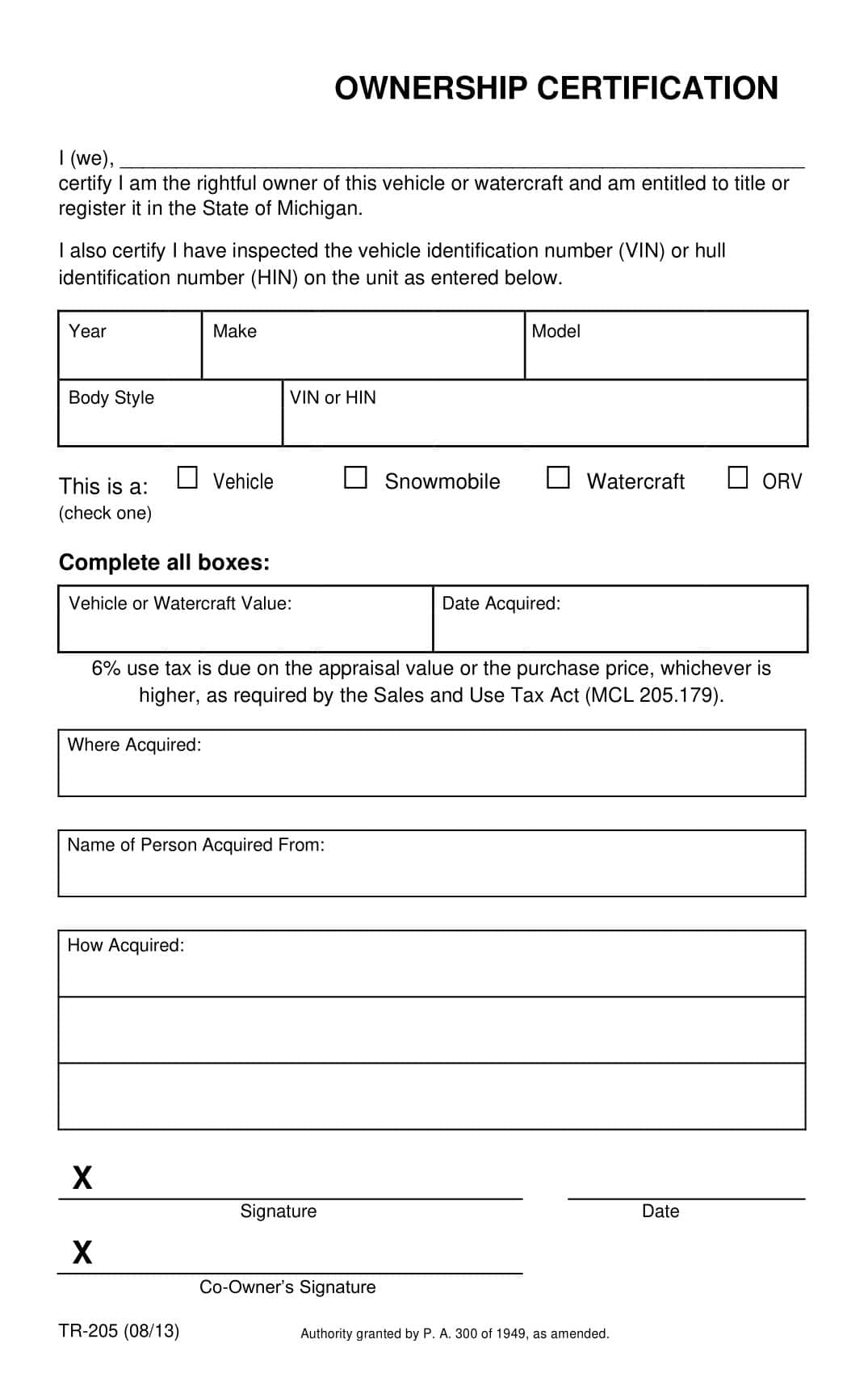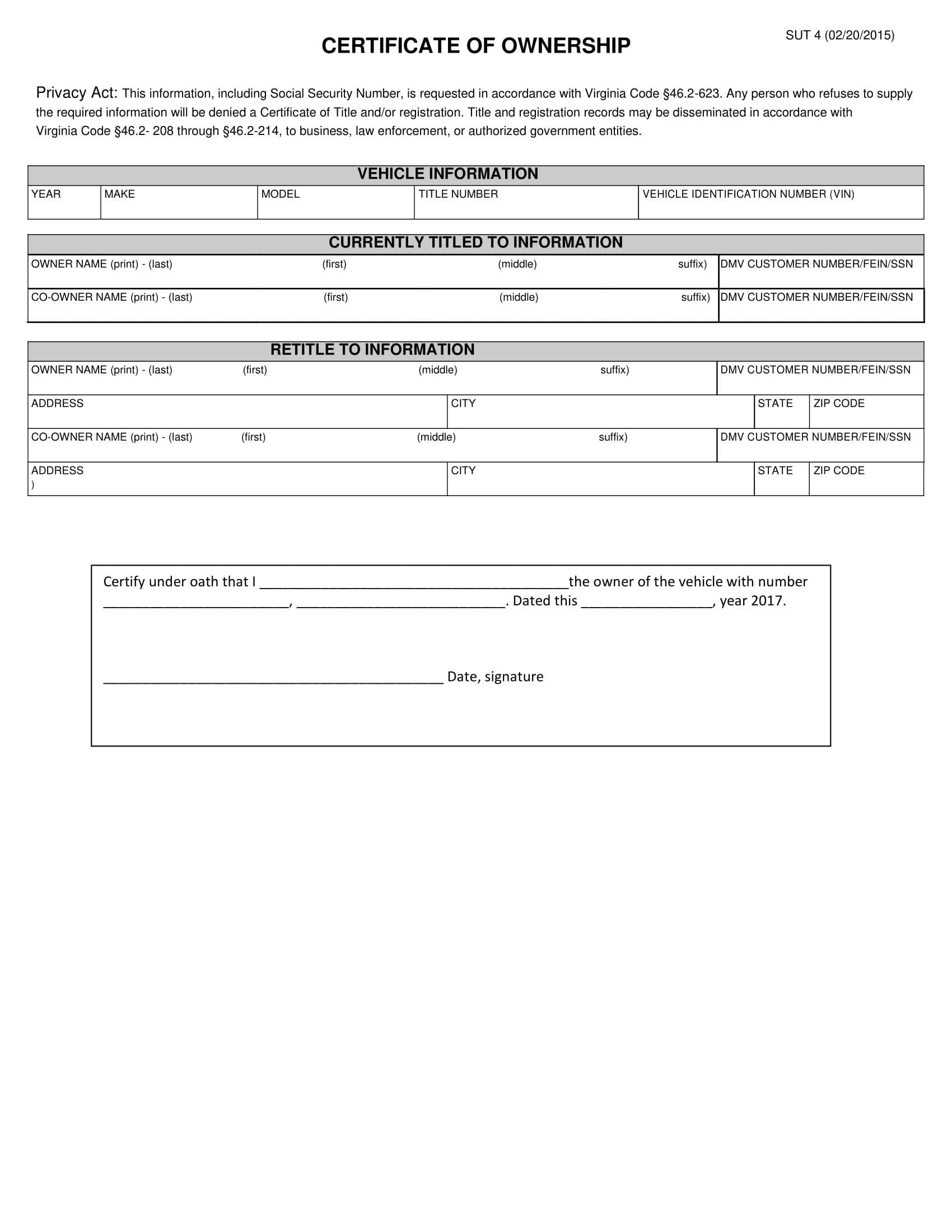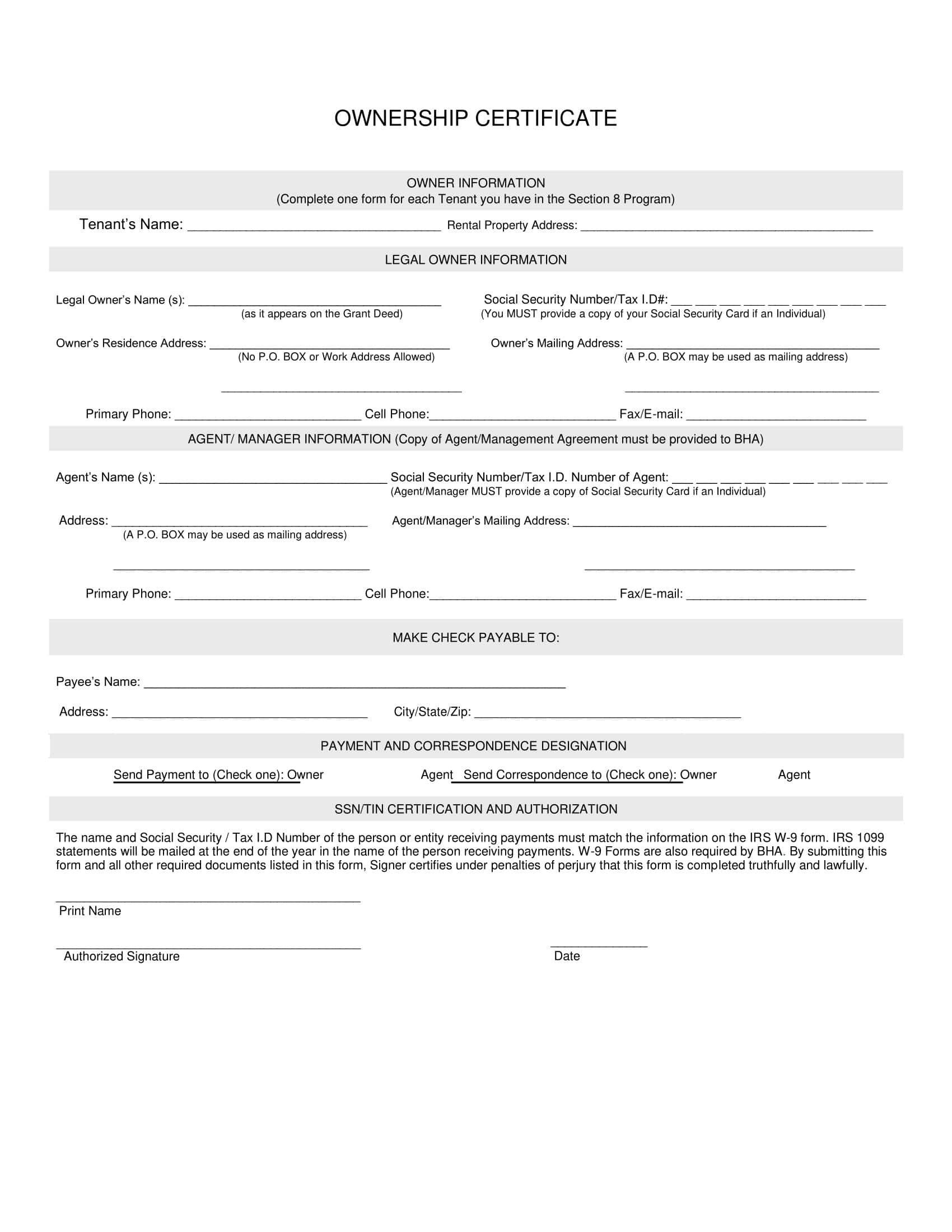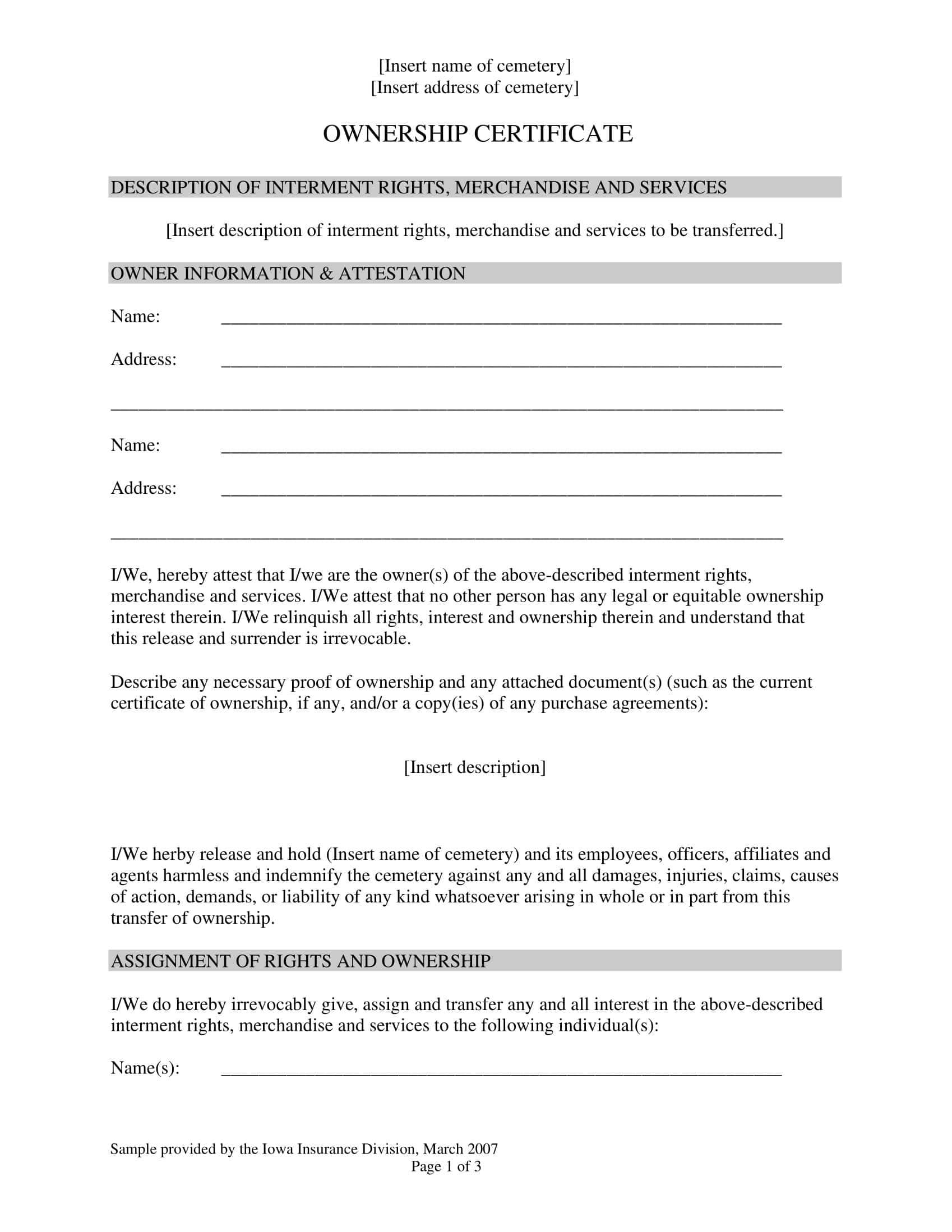Proof of ownership is an important document for any major purchase. Whether it’s a car, boat, or other high-value item, having the certificate that legally confirms ownership protects both buyer and seller. For vehicles, boats, and other titled property, the certificate of ownership is the key document that proves legal possession and the right to transfer the asset.
While requirements vary by state, certificates generally include vital details like the VIN/HIN, model information, and a legal statement verifying ownership. Having this official certificate readily available, especially during a sale or transfer, helps ensure a smooth transaction.
This article provides guidance on certificates of ownership, from what should be included to free printable templates that can be used to easily create a customized document. With the proper certificate in hand, both buyers and sellers can feel confident in the legitimacy of the sale.
Table of Contents
What is a Certificate Of Ownership?

A Certificate of Ownership is an important legal document that proves ownership and title for major assets like vehicles, boats, and other titled property. The Certificate of Ownership contains key details about the asset such as the VIN or HIN number, make/model information, owner’s name and address, and a statement verifying legal ownership. Certificates are required for registering and transferring ownership of titled assets, providing proof that the current holder is the legal owner. They are typically issued by government agencies like state DMVs at the time of sale or transfer.
Having the Certificate of Ownership readily available is crucial for providing legitimacy in transactions and protecting owners in case questions of ownership arise. The certificate enables the legal owner to register, insure, modify, and ultimately sell the titled property by definitively documenting their ownership status.
Certificate of Ownership Letter Templates
Owning property or a business is an accomplishment. An official certificate of ownership formally documents your rights. A certificate of ownership template allows you to create a customized document to certify your claim to an asset.
This template provides you with a traditional certificate layout suitable for framing. Customize it by adding the name of the property or business, location details, owner name, transfer date, and terms. For a business, you can include registration numbers, shareholders, and other specifics.
A certificate of ownership template makes generating official ownership certificates simple. Spend minutes personalizing the template then download and print on high-quality paper or parchment. Present a professional certificate of ownership displaying your name and rights to the property or business. It serves as legal proof and a meaningful memento representing your hard work and achievement. With a customized template, showcasing ownership is easy.
When Do You Need A Certificate Of Ownership?
The need for such a certificate varies across different types of assets and jurisdictions, but its primary purpose remains consistent: to officially document and confirm ownership. Here’s a detailed overview of scenarios where a Certificate of Ownership might be necessary:
Real Estate Transactions:
- Property Deed: Whenever real estate is bought or sold, a deed is provided to the new owner, acting as a Certificate of Ownership. This deed is then recorded with a local or state office, ensuring the buyer’s legal ownership.
Vehicles:
- Vehicle Title: When you purchase a vehicle, you receive a title, which is effectively a Certificate of Ownership for that vehicle. If you decide to sell or transfer ownership of the vehicle, the title must be transferred to the new owner.
Business Ownership:
- Shares in a Company: For corporations, ownership is often determined by shares. Shareholders receive stock certificates that prove their ownership percentage in the company.
- Business Licenses: Some jurisdictions might provide ownership certificates when issuing business licenses, proving that the individual or entity legally owns the business in question.
Intellectual Property:
- Patents, Trademarks, and Copyrights: When an individual or entity secures a patent, trademark, or copyright, they receive a certificate indicating their ownership of that intellectual property. This can be essential for legal protections and in cases where licensing or sales of the IP occur.
Personal Property:
- In some cases, particularly for high-value items like art, antiques, or collectibles, Certificates of Ownership or Authenticity can be provided to prove an individual’s ownership and the item’s authenticity.
Animals:
- For purebred pets, horses, or livestock, ownership certificates or registration papers may be issued. This can be crucial for breeding purposes, sales, or participation in certain competitions or shows.
Financial Instruments and Investments:
- Assets such as bonds might come with certificates signifying ownership. However, with the rise of electronic record-keeping, physical certificates for financial instruments have become less common.
Mining, Oil, and Gas Rights:
- If an individual or entity has rights to extract minerals, oil, or gas from a piece of land, they might have a Certificate of Ownership indicating their ownership of those rights, separate from land ownership.
Inheritance and Estate Planning:
- As assets are passed down through inheritance, Certificates of Ownership can play a role in ensuring that beneficiaries receive what is legally theirs.
Legal Disputes:
- In cases where ownership of an asset is contested or unclear, having a Certificate of Ownership can provide clarity and legal grounding.
Components of an Ownership Certificate
While the specifics can vary based on the type of asset and the jurisdiction, several common components are usually present in most Ownership Certificates. Here’s a detailed breakdown:
1. Title or Header:
This typically states the purpose of the document. For example, “Certificate of Ownership,” “Property Deed,” “Vehicle Title,” or “Stock Certificate.”
2. Name and Details of the Issuing Authority:
For many certificates, there’s an issuing authority, such as a government department, registrar, or company. Their name, address, contact information, and often a logo or seal will be displayed prominently.
3. Identification or Serial Number:
Many certificates have a unique identification or serial number for tracking and verification purposes.
4. Description of the Asset:
This section provides detailed information about the asset being owned:
- For real estate: Description of the property, including its address, boundaries, and any other relevant details.
- For vehicles: Details like make, model, VIN (Vehicle Identification Number), and color.
- For stocks or shares: Information about the company, stock type, and number of shares.
5. Owner’s Details:
This will include the name of the owner and relevant identification details. For individuals, this might be a residential address and identification number. For businesses or entities, it might be a business address, registration number, or tax ID.
6. Date of Issuance:
The date on which the certificate was issued. This might be different from the date of the actual transaction or event that transferred ownership.
7. Effective Date of Ownership:
The date from which the named individual or entity became the recognized owner of the asset.
8. Restrictions or Limitations:
Any conditions, restrictions, or limitations associated with the ownership might be listed. For example, certain rights might be reserved by the issuer, or there might be conditions under which the asset must be maintained.
9. Signatures:
Signatures from the issuing authority and, in some cases, the owner or a notary public, authenticate the document. This section might include:
- Signature of the issuing authority’s representative.
- Owner’s signature (especially in cases like vehicle titles).
- Notary public’s signature and seal, if the document has been notarized.
10. Seals or Embossments:
Official seals, logos, or embossments further authenticate the certificate and signify its official nature.
11. Terms and Conditions:
Some certificates might have a section dedicated to terms and conditions governing the use of the certificate or the asset it represents.
12. Transfer or Endorsement Section:
Particularly in cases like vehicle titles or stock certificates, there might be a section on the back or at the end where future transfers of ownership can be documented.
13. Expiry Date (if applicable):
In some instances, the certificate might have a validity period, after which it needs to be renewed or reissued.
How To Transfer Ownership
Transferring ownership is a key part of finalizing any major sale, especially for significant assets like vehicles, boats, properties, and businesses. Properly completing the ownership transfer process protects both buyer and seller by officially documenting the change. While specific requirements vary, there are general steps to follow for smoothly navigating ownership transfers.
For titled property like cars, boats, RVs, and trailers, the ownership transfer involves exchanging the title certificate and registering the asset under the new owner’s name. For real estate, the ownership change is completed by filing a new deed with the county records office. Transferring business ownership requires updating registration documents, tax IDs, licenses, and other corporate records.
Here are the main steps for transferring ownership:
Manufactured Homes
Step 1: Obtain and Complete the Title Transfer Forms
Contact your state’s Department of Housing or a similar authority that oversees the transfer of manufactured homes. Request the necessary transfer of ownership forms. Carefully fill out all required sections, ensuring that buyer and seller details are accurate.
Step 2: Pay Off Any Liens or Loans
Ensure that any outstanding loans, liens, or encumbrances on the manufactured home are fully paid off. Ownership transfers can’t usually proceed if there’s an outstanding debt on the home. Secure a release of lien document if applicable.
Step 3: Secure a Bill of Sale
Draft a bill of sale detailing the transaction. This should include the home’s description, sale price, and date of sale. Both parties should sign the document.
Step 4: Submit Documentation and Fees
Take all the necessary documents, including the title transfer forms, bill of sale, and release of lien (if applicable) to the appropriate government agency. Pay any required transfer fees.
Motorcycles, Cars, or Trucks
Step 1: Complete the Title Transfer Forms
Each state’s Department of Motor Vehicles (DMV) or equivalent agency provides title transfer forms. Obtain and complete these forms, making sure all details are accurate.
Step 2: Verify Vehicle Inspection and Emissions Testing
In some states, vehicles must undergo inspections or emissions testing before transfer. Check local requirements and ensure the vehicle meets all criteria.
Step 3: Create a Bill of Sale
Draft a bill of sale containing all details of the transaction, including vehicle description, sale price, and transaction date. Both buyer and seller should sign this document.
Step 4: Submit Documentation and Fees
Present the completed title transfer forms, bill of sale, and any other required documents to the DMV. Pay the associated transfer fees.
Motorized Boats
Step 1: Contact the Appropriate Boating Authority
Get in touch with the state’s boating or maritime authority. Request the necessary boat title transfer forms and fill them out accurately.
Step 2: Secure Boat Inspection (if required)
Certain states or regions may require a boat to be inspected before title transfer. Ensure all requirements are met and secure documentation proving the boat’s condition.
Step 3: Draft a Bill of Sale
Create a detailed bill of sale that includes the boat’s specifications, transaction price, and date of sale. Both parties must sign.
Step 4: Submit Documentation and Fees
Submit the title transfer forms, bill of sale, and any additional documents to the relevant boating authority. Pay all associated transfer fees.
Trailers
Step 1: Acquire and Fill Out the Title Transfer Forms
Reach out to your state’s DMV or equivalent to get the appropriate trailer title transfer forms. Complete these forms with accurate details.
Step 2: Ensure the Trailer Meets State Standards
Certain states may have specific standards or inspections required for trailers. Confirm any requirements and make sure your trailer adheres to them before proceeding with the transfer.
Step 3: Create a Bill of Sale
Draft a comprehensive bill of sale detailing the trailer’s specifications, the transaction’s price, and the sale date. Both buyer and seller should sign the document.
Step 4: Submit Documentation and Pay Fees
Take the filled-out title transfer forms, the bill of sale, and any necessary supplementary documents to the DMV or relevant authority. Pay the required transfer fees.
Certificate of Title vs. Deed?
Both the “Certificate of Title” and “Deed” are legal documents associated with the ownership and transfer of property. While they have overlapping purposes, they serve distinct roles and have different implications in the property transaction process. Here’s a detailed comparison:
Function:
A Certificate of Title and a Deed serve distinct roles when it comes to property ownership. The Certificate of Title is a document that confirms who the current owner of a property is and provides a history of ownership. It acts as an evidence-based representation of ownership. In contrast, a deed doesn’t just represent ownership; it actively facilitates the transfer of property ownership. When a property is sold or its ownership is otherwise transferred, it’s the deed that signifies and realizes this change.
Guarantee:
The level of guarantee provided by these two documents varies. Deeds, especially warranty deeds, offer assurances against undisclosed interests, meaning they provide a guarantee that the seller has a clear title free of any hidden claims or liens. This provides the buyer with protection against future title disputes. On the other hand, a Certificate of Title, while showing the property’s ownership and any known encumbrances, doesn’t necessarily guarantee a “clear title.” There may still be potential hidden defects or claims not listed, which is why many buyers opt for title insurance alongside their Certificate of Title.
Issuance:
The origins and issuance processes for the two documents differ significantly. Deeds are usually drafted by professionals such as attorneys, especially when involved in real estate transactions. Their creation is rooted in the transaction itself, with details tailored to the specific sale or transfer. In contrast, Certificates of Title are commonly issued by a centralized authority, be it a government agency, registry, or title company. Their issuance comes after a thorough review of property records and, in some cases, after the deed has been presented as evidence of the new ownership.
Role in Sales Process:
When a property undergoes a transaction, both documents play pivotal, sequential roles. The process typically begins with the seller providing the buyer with a deed, transferring ownership rights. Once this transfer is facilitated through the deed, the buyer can then use it as evidence of their new ownership. This evidence is what’s required to update or obtain a new Certificate of Title. In essence, while the deed initiates and verifies the transfer of property, the Certificate of Title serves as the updated, official record of this change.
Conclusion
Proof of ownership is critical for major purchases and transfers, but obtaining a Certificate of Ownership doesn’t need to be complicated. Whether transferring a vehicle title or boat registration, following the proper documentation steps smooths the process. Be sure to consult your local state laws for specific requirements. We’ve provided downloadable Certificate of Ownership templates and samples that can be customized as needed.
With a valid ownership certificate in hand, buyers and sellers alike can have peace of mind that transactions are legitimate and backed by an official record. The Certificate of Ownership is an essential document that legally verifies asset possession, enables registration and insurance coverage, and protects owners in case disputes arise. Be sure to keep your certificates in a safe place for easy access. They are the key proof that you are the lawful owner.
FAQs
Is a Certificate of Ownership legally binding?
Yes, it is a legal document that certifies the ownership of an asset and can be used as evidence in legal disputes regarding ownership.
How do I obtain a Certificate of Ownership?
The process for obtaining a Certificate of Ownership varies depending on the jurisdiction and the type of asset in question. For real estate, this usually involves a transfer of title or a registration process through a local government office.
What is the difference between a Certificate of Ownership and a Certificate of Authenticity?
A Certificate of Ownership verifies the ownership of an item, while a Certificate of Authenticity verifies the genuineness or originality of an item, especially in the context of artworks, collectibles, or branded goods.
What information is typically included in a Certificate of Ownership?
It usually includes details about the asset (e.g., description, size, location), the name of the owner, any identifying numbers, and may also contain details of any encumbrances or liens on the asset.
How long is a Certificate of Ownership valid?
As long as the owner retains ownership of the asset and there are no changes in the legal status of the asset, the certificate remains valid. However, it’s crucial to update or re-register the certificate if there are any changes in ownership or asset details.
Do I need a lawyer to obtain or transfer a Certificate of Ownership?
While it’s not always necessary, it’s often advisable to consult with a lawyer, especially when dealing with valuable assets or real estate, to ensure all legal procedures are correctly followed.
How much does it cost to obtain or transfer a Certificate of Ownership?
The cost can vary significantly depending on the type of asset, the jurisdiction, and any fees associated with registration or transfer. It’s best to check with local authorities or professionals familiar with the process in your area.














































![Free Printable Estoppel Certificate Templates [PDF, Word] Tenant 1 Estoppel Certificate](https://www.typecalendar.com/wp-content/uploads/2023/05/Estoppel-Certificate-1-150x150.jpg)
![%100 Free Hoodie Templates [Printable] +PDF 2 Hoodie Template](https://www.typecalendar.com/wp-content/uploads/2023/05/Hoodie-Template-1-150x150.jpg)
![Free Printable Ordination Certificate Templates [Minister & Deacon] Word, PDF 3 Ordination Certificate](https://www.typecalendar.com/wp-content/uploads/2022/11/Ordination-Certificate-150x150.jpg 150w, https://www.typecalendar.com/wp-content/uploads/2022/11/Ordination-Certificate-120x120.jpg 120w, https://www.typecalendar.com/wp-content/uploads/2022/11/Ordination-Certificate-1200x1200.jpg 1200w)
